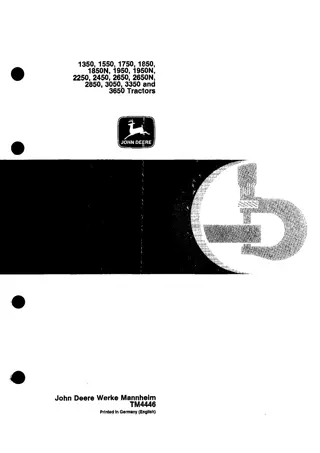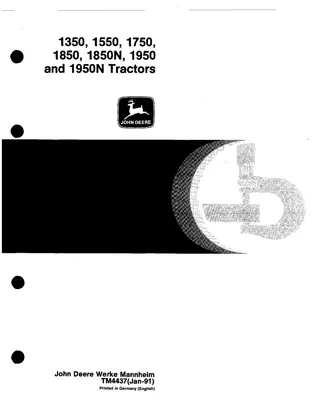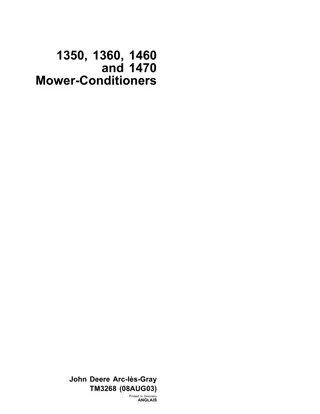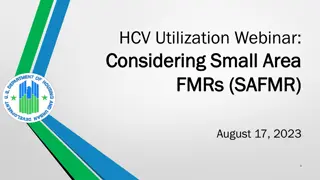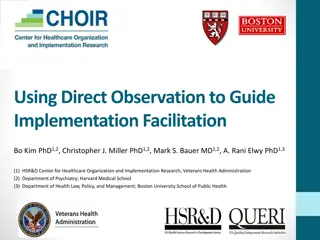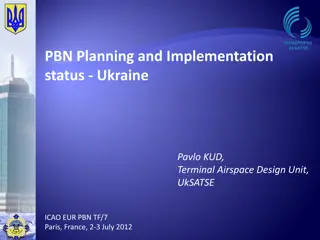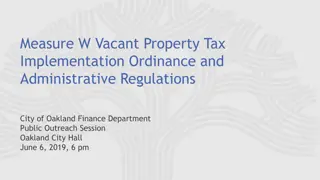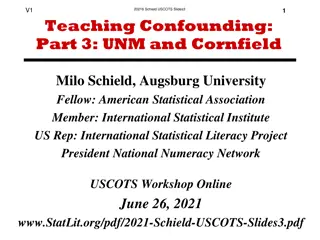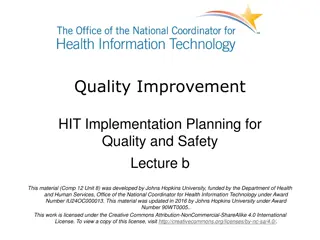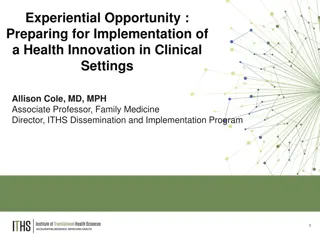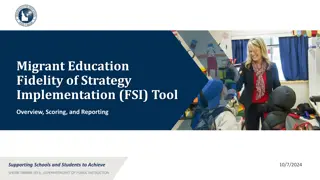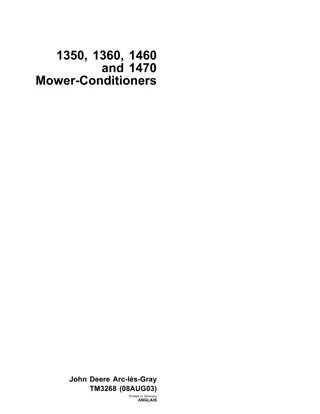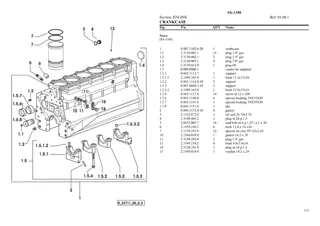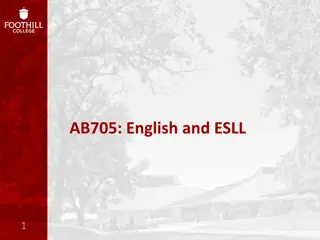
Achieving Low Latency Wi-Fi Through L4S Technology
Explore how L4S technology is aimed at reducing buffer delays and achieving low latency in Wi-Fi networks. Learn about the key components of L4S architecture and its impact on congestion control, as well as the proposed implementations in the IEEE 802.11bn standard. Discover the test results comparing classic TCP flows with L4S flows in different scenarios, highlighting the benefits of L4S in reducing latency in Wi-Fi networks.
Download Presentation

Please find below an Image/Link to download the presentation.
The content on the website is provided AS IS for your information and personal use only. It may not be sold, licensed, or shared on other websites without obtaining consent from the author. If you encounter any issues during the download, it is possible that the publisher has removed the file from their server.
You are allowed to download the files provided on this website for personal or commercial use, subject to the condition that they are used lawfully. All files are the property of their respective owners.
The content on the website is provided AS IS for your information and personal use only. It may not be sold, licensed, or shared on other websites without obtaining consent from the author.
E N D
Presentation Transcript
Sept 2024 doc.: IEEE 802.11-24/1350r2 Introduction UHR PAR scope includes the reduction of tail latency Achieving Low Latency Wi-Fi requires to reduce both Buffer delays that occur when packet arrivals exceed departures and lead to high buffer occupancy. Media access delays in scenarios with moderate/high airtime contention L4S technology defined by IETF RFCs [1-3] supports end-to-end low latency, including tail latency, with low packet loss Address buffer delays Overview of L4S presented in [4][13] and proposals to support L4S in 802.11bn presented in [5-9] This presentation covers: A recap on L4S architecture L4S test results showing how L4S reduces buffer delays Recap on proposed L4S implementations in 802.11bn in the AP AP MAC enhancement proposal for efficiently supporting L4S above the MAC Submission Slide 2 Lili Hervieu et al (CableLabs)
Sept 2024 doc.: IEEE 802.11-24/1350r2 Recap on L4S architecture: Key Components L4S introduces new rules for internet congestion control: L4S uses the explicit congestion notification (ECN) in the IP header to explicitly signal congestion early and frequently. ECN indicates congestion before the network gets to the point of dropping packets When the receiver gets packets that are marked with congestion experienced, the receiver relays these congestion marks back to the sender so that the sender can adjust its sending rate and react more subtly to congestion. The sender can fine- tune transmission rates more accurately and quickly. Submission Slide 3 Lili Hervieu et al (CableLabs)
Sept 2024 doc.: IEEE 802.11-24/1350r2 Recap on L4S architecture: Key Components L4S active queue management (AQM) applies CE-marks to packets at a very shallow buffer threshold To coexist with classic congestion-control traffic, Dual-Queue Coupled AQM uses 2 queues, one for L4S traffic and 1 for classic traffic. It isolates L4S flows from the queuing of classic flows and sends congestion signals appropriately scaled for each type of traffic. The classic AQM applies a drop level to classic traffic that is coupled to the CE marking level being applied to low latency (LL) traffic in such a way that packet rates of the two types of flow turn out roughly the same. Propose to support L4S for best effort (AC_BE) and video (AC_VI). AC_VO is tbd. Submission Slide 4 Lili Hervieu et al (CableLabs)
Sept 2024 doc.: IEEE 802.11-24/1350r2 Nokia Beacon 6 L4S Test Setup Test conducted on a clean 5 GHz channel 20 MHz bandwidth with 1 AP and 1 STA Tests compares classic flows (TCP CUBIC) versus L4S flows (TCP Prague) when L4S is enabled and disabled on the APUT. Unlimited iperf3 flows Report average downlink throughput and downlink one way latency (P50, P90, P95, P99) 2 scenarios reported: one with a stationary client and one with a moving client L4S (A)) ON/OFF refers to enabling/disabling dual-queue coupled AQM and CE marking on the AP Submission Lili Hervieu et al (CableLabs)
Sept 2024 doc.: IEEE 802.11-24/1350r2 L4S Test Results 1 Stationary Client DN DN Classic FLOWS DN Latency P50 ms DN Latency P90 ms DN Latency P95 ms DN Latency P99 ms L4S DN Latency P50 ms DN Latency P90 ms DN Latency P95 ms DN Latency P99 ms AP L4S Throughput Mbps 218 210 205 Throughput Mbps FLOWS OFF OFF OFF OFF OFF OFF ON ON ON ON ON ON 1 2 4 90 104 217 111 118 244 116 121 252 128 127 266 1 2 4 204 198 202 105 122 131 126 214 179 131 224 198 141 242 222 1 2 4 193 192 203 8 9 12 12 14 17 13 15 19 16 19 22 1 2 4 183 186 188 5 5 6 8 8 9 9 9 10 11 11 13 ON ON 1 2 92 106 7 10 14 18 16 21 21 26 1 2 105 90 6 6 8 8 9 9 11 11 1 row is 1 test result Test result shows the benefit of L4S, reducing latency from ~200 ms when L4S is disabled down to ~20 ms (CUBIC) and ~11 ms (Prague) when L4S is enabled. More than 10X reduction in latency, less than 16% reduction in throughput Latency reduction more significant with multiple concurrent flows Submission Lili Hervieu et al (CableLabs)
Sept 2024 doc.: IEEE 802.11-24/1350r2 L4S Tests Results 1 Stationary client Submission Slide 7 Lili Hervieu et al (CableLabs)
Sept 2024 doc.: IEEE 802.11-24/1350r2 L4S Test Results 1 Moving Client Wi-Fi 6 AP located in the office Client (laptop) moves quickly from the office through hallway, bedroom and bathroom. Client stays for a couple of seconds in bathroom Client moves back quickly to the office. ---Client position throughout the test (clients stays a couple of seconds in bathroom) Submission Lili Hervieu et al (CableLabs)
Sept 2024 doc.: IEEE 802.11-24/1350r2 L4S Test Results 1 Moving Client AP L4S OFF OFF OFF ON ON ON Classic FLOWS 1 1 1 1 1 1 DN DN Latency P50 145 157 141 DN Latency P90 315 306 313 DN Latency P95 358 389 360 DN Latency P99 568 527 520 L4S FLOWS DN DN Latency P50 DN Latency P90 DN Latency P95 DN Latency P99 Throughput 121 117 124 Throughput 1 1 1 93 93 91 4 3 4 12 9 11 16 12 15 27 23 25 L4S reduces P99 latency by 500 msec with less than 20% throughput reduction Throughput in Mbps, latency in msec Submission Lili Hervieu et al (CableLabs)
Sept 2024 doc.: IEEE 802.11-24/1350r2 Summary of Tests L4S significantly reduces the latency while moderately reducing the throughput when latency is due to buffer delays Dual-queue coupled AQM benefits L4S flows and also classic flows L4S further reduces latency for L4S flows and leads to no packet drop Lower packet drop may have a significant impact on applications that are sensitive to packet loss. L4S leads to smoother throughput due to new congestion control mechanism May lead to better trigger access scheduling Submission Slide 10 Lili Hervieu et al (CableLabs)
Sept 2024 doc.: IEEE 802.11-24/1350r2 L4S Integration in 802.11bn MAC Proposals Recap [6][7][8][9] L4S traffic classification support by: Adding an L4S field in the TCLAS element (if supporting SCS) Adding an L4S parameter in the MA-UNITDATA.request primitive (if not supporting SCS) DUAL-queue coupled AQM in the 802.11 MAC for BE and VI category to isolate L4S flows and classic flows and calculate congestion signals appropriately scaled for each type of traffic. Schemes to notify congestion to the non-AP STA assuming no CE marking at MAC layer When congestion is experienced at the MAC, it is signaled to the upper layer/L3 with a new L4S-CE.indication primitive and the upper layer CE-mark subsequent packets. When an MSDU experiences congestion at the MAC, the MSDU is sent to the upper layer for CE marking, and after marking the MSDU is inserted back in the MAC queue at the same place. This is based on a new L4S-CE-MARKING.request/response primitive. Transmit the congestion notification between AP and the STA with L2 CE signaling in A-control field. When STA receives a data frame with L4S CE in A-Control, it requests upper layer to add L3 CE marking with new L4S-CE-MARKING.request/response primitive Drawing from 802.11-2024/399 Submission Slide 11 Lili Hervieu et al (CableLabs)
Sept 2024 doc.: IEEE 802.11-24/1350r2 MAC Enhancement for Efficiently Supporting L4S Above the MAC - Principal Dual-queue coupled AQM is implemented above the MAC (BE and VI) and handles traffic classification and congestion signals, including CE-marks in the IP headers. Need to maintain a shallow queue in the MAC queue to try to ensure that the AC queue is populated to a degree that it can efficiently use the link capacity (i.e. fill each TXOP) and no bigger, while all of the rest of the queued packets are maintained in the L4S queuing structure above the MAC. AC buffer is typically 1 to 2 TXOP worth of data => buffer size not constant (depends on PHY rate, TXOP etc.) Diagram applies to AC_VI as well AC_VO is tbd Submission Slide 12 Lili Hervieu et al (CableLabs)
Sept 2024 doc.: IEEE 802.11-24/1350r2 MAC Enhancement for Efficiently Supporting L4S Above the MAC - Principal Unsaturated operation (by reference to AC-BE) AC_BE buffer not full, AQM is just a no operation pass through Saturated operation: At enqueue: C-queue packet drops and LL-queue packet marks (based on coupled probability). At dequeue, when a BlockAck creates space in AC_BE - M packets from C-queue and K packets from LL queue are dequeued. Some number of packets may be left in the LL-queue (N) - CE-mark an additional N packets in the dequeued packets [13] provides architecture details and NS3 simulation results based on this architecture (NS3 model to be available soon) Diagram applies to AC_VI as well AC_VO is tbd Submission Slide 13 Lili Hervieu et al (CableLabs)
Sept 2024 doc.: IEEE 802.11-24/1350r2 MAC Enhancement for Efficiently Supporting L4S Above the MAC - Principal Flow control is needed between the MAC and the upper layer Upon reception of a BlockAck, MAC notifies the upper layer the number of bytes available in the AC buffer Propose a new L4S-MAC-buffer-availability.indication (MAC-SAP or MLME) primitive L4S-MAC-buffer-availability.indication( source address, destination address, priority, Bytes_to_buffer_full ) Diagram applies to AC_VI as well AC_VO is tbd Submission Slide 14 Lili Hervieu et al (CableLabs)
https://slideplayer.com/slide/2525044/ Sept 2024 doc.: IEEE 802.11-24/1350r2 L4S Capability Signaling APs and STAs need to signal L4S capabilities Non-AP STAs use this information in their AP selection process APs to provision for L4S support for the client supporting L4S L4S related capabilities can be signaled in Capabilities element Submission Slide 15 Lili Hervieu et al (CableLabs)
Sept 2024 doc.: IEEE 802.11-24/1350r2 Summary L4S significantly reduces the latency caused by ingress/egress rate mismatch Achieving very low latency relies on reducing media access delay in combination with L4S 802.11 features to reduce media access delay (e.g., SCS, EDCA). As these features may not be available (e.g., residential deployments where all traffic is sent to AC_BE), it is important to consider new techniques to reduce media access delays such as proposed in [10][11][12] We propose to support L4S Dual-Queue Coupled AQM above the 802.11 MAC layer for AC_BE and AC_VI. This requires: Shallow AC buffer - 1 to 2 TXOP worth of data Buffer size will change over time Propose L4S-MAC-buffer-availability.indication primitive (MAC-Sap or MLME) to notify the upper layer the number of bytes available in the AC buffer upon reception of a BlockAck L4S related capabilities to be signaled in Capabilities element Submission Slide 16 Lili Hervieu et al (CableLabs)
Sept 2024 doc.: IEEE 802.11-24/1350r2 References [1] IETF RFC 9330 Low Latency, Low Loss, and Scalable Throughput (L4S) Internet Service: Architecture [2] IETF RFC 9331 The Explicit Congestion Notification (ECN) Protocol for Low Latency, Low Loss, and Scalable Throughput (L4S) [3] IETF RFC 9332 Dual-Queue Coupled Active Queue Management (AQM) for Low Latency, Low Loss, and Scalable Throughput (L4S) [4] 11-23/2065, WNG, End-to-End Congestion Control, L4S and Implications for Wi-Fi [5] 11-24-0080-01-0arc-l4s-over-wi-fi-links [6] 11-23-0679-00-0uhr-low-latency-qos-based-on-l4s [7] 11-24-0384-01-00bn-low-latency-based-on-l4s [8] 11-24-0399-01-00bn-thoughts-on-l4s-in-wi-fi [9] 11-23-0650-01-0uhr-qos-re-visited [10]11-24-0031-00bn-Deterministic-Backoff [11] 11-23-2126-03-00bn-low-latency-channel-access-follow-up [12] 11-24-0773-01-00bn-csma-with-enhanced-collision-avoidance [13] https://www.ieee802.org/11/private/liaisons/WBA_2024_E2EQOS_L4S_v1.0.0%20-%20for%20IEEE%20802.11.pdf Submission Slide 17 Lili Hervieu et al (CableLabs)
Sept 2024 doc.: IEEE 802.11-24/1350r2 SP SP1: Do you agree to define L4S capability element to communicate support for L4S Capabilities element is tbd SP2: Do you agree to define primitive(s) in 802.11bn to support L4S above the 802.11 MAC Primitive(s) is/are tbd Submission Slide 18 Lili Hervieu et al (CableLabs)

